Welcome to New Player’s Guide, the first stop on your journey to playing D&D. This series has advice for players who’ve just joined their first D&D campaign, as well as Dungeon Masters who want help taking their new campaign to the next level. To see the other articles in this series, check out the New Player’s Guide tag—and for the brass-tacks information on how to start playing D&D, click on the New Player Guide link at the top of this page!
Hold up, Dungeon Master! This article follows up on last week's installment of New Player's Guide: How to Try Tactical Combat. If you haven't read that article yet, start there.
You can bust out a map and miniatures for as many encounters as you want, but those alone don’t make an encounter tactical. They’re vital components, but they’re not the only part. Tactical combat encounters tend to be more complex than other combat encounters because tactics involves decisions. If your encounter takes place in a featureless 40-foot-by-40-foot square room with three hobgoblin warriors, neither you nor your players are going to feel mentally engaged.
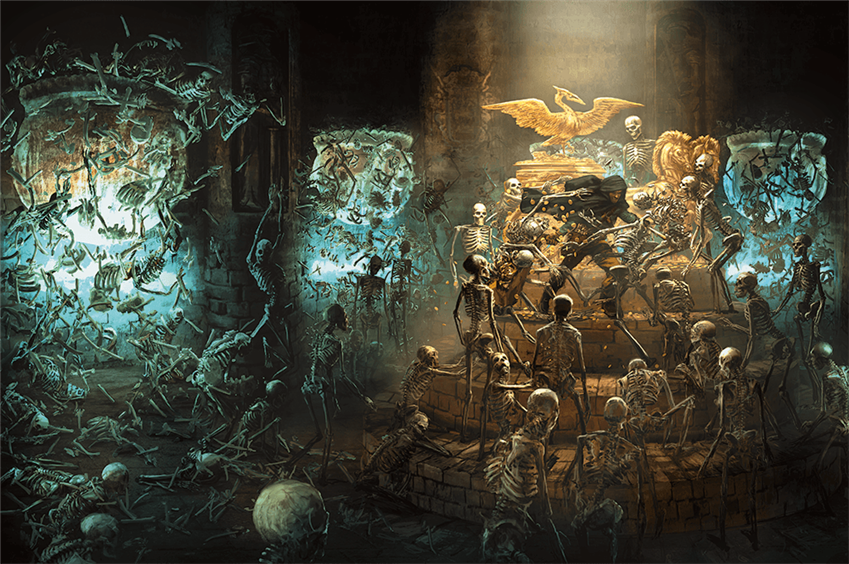
Let’s talk briefly about the first thing most D&D players think of when the word “tactics” is mentioned: maps and miniatures.
Are Maps and Miniatures Tactics?
With the sole exception of funny-shaped dice, what could be more iconic to D&D than a map split into 5-foot squares and little plastic or pewter miniatures that represent the heroes and monsters? These game aids aren’t necessary for tactical play, but they do help answer the questions “Where are we? What does the area look like? And what might be dangerous to us?” quickly and visually. Those are the sort of primeval, monkey-brain question that anyone might ask in a potentially dangerous area like a monster-filled dungeon.
You don’t necessarily need to include maps and miniatures in every encounter. It’s totally reasonable for a DM to run simple encounters with only one or two monster types and simple terrain solely in the Theater of the Mind—that is, simply describing the encounter and having every player imagine the battle solely in their minds’ eyes. And then you bust out the maps and minis when the characters start an encounter with lots of tactical depth.
Having a persistent representation of the game world is vital when you start layering complex tactical information on top of a combat or exploration scenario. If you’re worrying about five different types of enemies and three different types of traps, and your players have cast grease on a specific part of the map and spirit guardians on another part—well, there’s no way every single player can keep all that information straight in their heads. When encounters get complex, the Theater of the Mind breaks down and arguments start happening.

“I was more than 60 feet away from the beholder, it couldn’t have hit me with its disintegration ray!” one of your players might say, understandably upset when their beloved warlock is turned to dust by a beholder they thought they were safely distant from. When you have a map divided into 5-foot squares and use miniatures to mark every creature’s position, it’s easy to resolve arguments like this. Just count the squares.
And if you aren’t worried about mishaps like this, you don’t need to include a grid. Just draw or upload an ungridded image and place miniatures or digital tokens on it. This way, you can have a map with relatively abstract distances for fast-and-loose play while still benefiting from seeing everyone’s relative positioning on the map.
However. Even though maps and miniatures are an iconic part of tactical D&D play, focusing solely on the physical representation of the game misses the forest for the trees. There are three core components of tactical play that go far deeper than just rolling out a map and placing figurines or tokens on it. If you want to build encounters that can only be played in a tactical style, then you need to go beyond simple maps and minis.
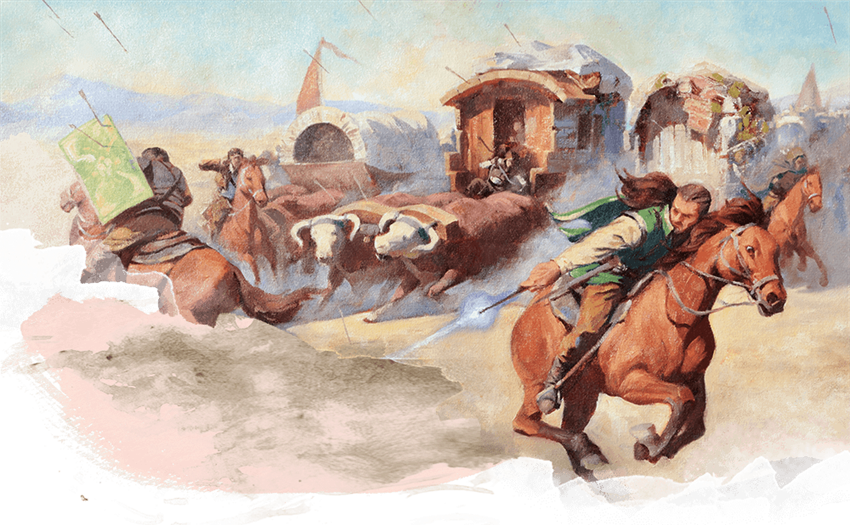
The Building Blocks of Tactical Gameplay
Whenever you sit down to create a tactical encounter—or when you start thinking about how to spruce up an encounter you found in a published adventure—start by thinking about the three fundamental components of encounter design.
- Terrain
- Monsters
- Win conditions
Let’s break these down. You don’t have to figure out all three for every encounter you create, but try to consciously include at least two elements, and think deeply about at least one of them. Doing this will instantly make your encounters more engaging.
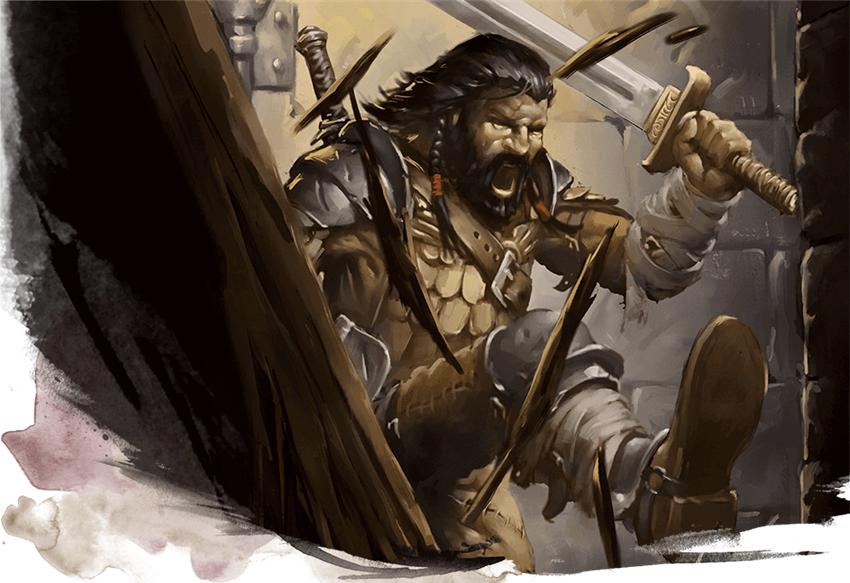
Terrain and Positioning
Just like every part of tactical design, a great encounter has terrain that does double duty: it makes the tactics more interesting, and it tells a compelling story. Consider how we could improve this encounter area, an ancient temple’s treasure vault:
This vault is 40 feet wide and 80 feet long, and its floor is covered with coins and jewels. At the far end of the hall is a statue of a woman in sacred regalia. Hidden beneath piles of gold are concealed pit traps with deadly spikes at the bottom. Eight skeletons with longbows and ceremonial longswords, all of whom attack the characters as they enter. At the back of the room is their master, a lamia who wishes to annihilate the interlopers, though she tries to force the characters to surrender so she can trick the characters into accepting a geas that will compel one of them to kill the others for her amusement.
This is a great encounter, but it could be made better and even more tactical through the use of compelling terrain. Here are three ways you can do this through terrain alone.
- Create elevated terrain; perhaps four pairs of 10-foot-square areas that are elevated 20 feet above the ground, spaced every 15 feet down the hall. Position the skeletons atop these pillars, allowing them to safely shoot at the characters from afar as they try to run down this hall. Also, make the statue a gigantic piece of terrain that fills the entirety of the back wall. Her cupped hands can be a 5-foot-by-10-foot platform that the lamia rests on, about 30 feet above the ground. This gives her an unimpeded view of the room and keeps her safe from melee.
- Place the pit traps in the gaps between these raised platforms. This forces characters to either engage the skeletons head on or fall through the concealed pit traps.
- Replace one of the lamia’s spells to make her more threatening at range, which is how she’ll engage the party for the most of the encounter. Swap scrying with scorching ray. The party might even use the tall terrain as cover to keep out of her line of sight, thus preventing her from casting scorching ray at the concealed characters.
Instantly, the encounter is improved by creating more diverse terrain and specifying the starting position of each monster. Did you notice another element of terrain that makes this encounter unusual? The distance at which the enemies are encountered massively changes the way the encounter plays. This is just another facet of positioning. Spacing out the skeletons in groups makes each pair of pillars into a micro-encounter that the characters have to deal with in order to reach the lamia. Consider starting an encounter in the wilderness at an extreme range of 1,000 feet or more to give the adventurers and their foes options as one approaches the other, possibly with a hail of longbow shots. This could turn a combat encounter into a chase, or even an attempt to hide and sneak away.
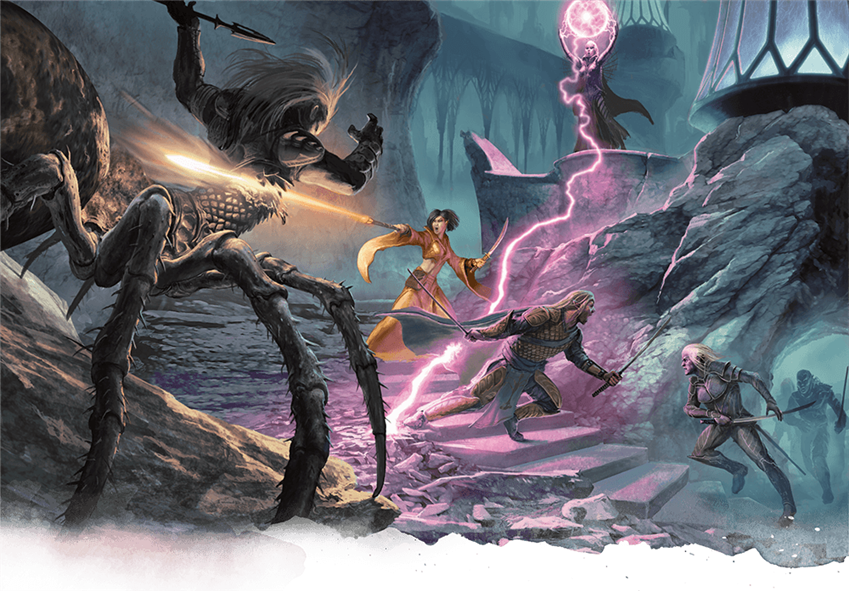
Monsters and Hazards
A good tactical encounter uses two or even three different types of monsters. They don’t have to be different species, but they should serve different roles. In other words, you should have several different groups of monsters that do different things. In every encounter, try to have at least two groups of monsters with different strengths, such as:
- Minions (melee), a group of weak enemies that specialize in melee combat; individually, they have a challenge rating several points lower than the party’s level.
- Minions (ranged), a group of weak enemies that specialize with ranged weapons or spells; individually, they have a challenge rating several points lower than the party’s level.
- Minions (support), a group of weak enemies that use magic to hinder enemies or buff allies; individually, they have a challenge rating several points lower than the party’s level.
- Elite, a strong monster that the characters will have to spend several turns defeating. It has a challenge rating roughly equal to the party’s level.
- Boss, the leader of minions and elites; usually the encounter’s strongest monster, but sometimes it uses ranged attacks and spells to support its minions and elites. It has a challenge rating one or two points higher than the party’s level.
Design Tip: Magic Items
As the characters gain magic items, they start to break the encounter building guidelines. You can stretch the definition of elite and boss monsters to be stronger and stronger as the characters gain magic items and other forms of power beyond simply gaining levels.
The monsters in the Monster Manual and Basic Rules don’t use these unofficial classifications. They’re just broad categories to help you think of monsters in different ways. When a party gets stronger, you can turn elite monsters that the characters faced several levels ago into minions to show how much more powerful they’ve become. You can enhance the importance of the terrain by filling your encounter with monsters with different combat roles (melee, ranged, or support). This requires your players to make decisions; what enemy is more important, the big beefy monster in our face, or the creature buffing it? Or is it the minions shooting at us from afar?
Don’t overlook the power of traps and environmental hazards, either. Even though traps and hazards are stationary, they can be put to great use in combat. Monsters can try to push characters into burning braziers to deal damage, or into deep pits to temporarily remove characters from combat for a turn or two so that they can focus on defeating other adventurers. Concealed traps can shake up an otherwise predictable combat with surprising new information, and make your players consider precisely where their characters want to move.
In the example of the ancient treasure vault above, there are two categories of monsters and one type of trap. The lamia is the boss of this encounter, and she has a group of ranged minions spread out across the battlefield. There are several spiked pit traps that force the characters to move through the room in an unorthodox fashion, or risk taking damage. Following this rule of three different “moving parts” in an encounter is a good strategy. It’s a good level of complexity that’s still easy for everyone at the table to casually keep track of.
Five different monsters or hazards is a good upper limit for a climactic battle. Playing a battle with more than five moving parts is mentally exhausting for all but the most seasoned tactical veterans.
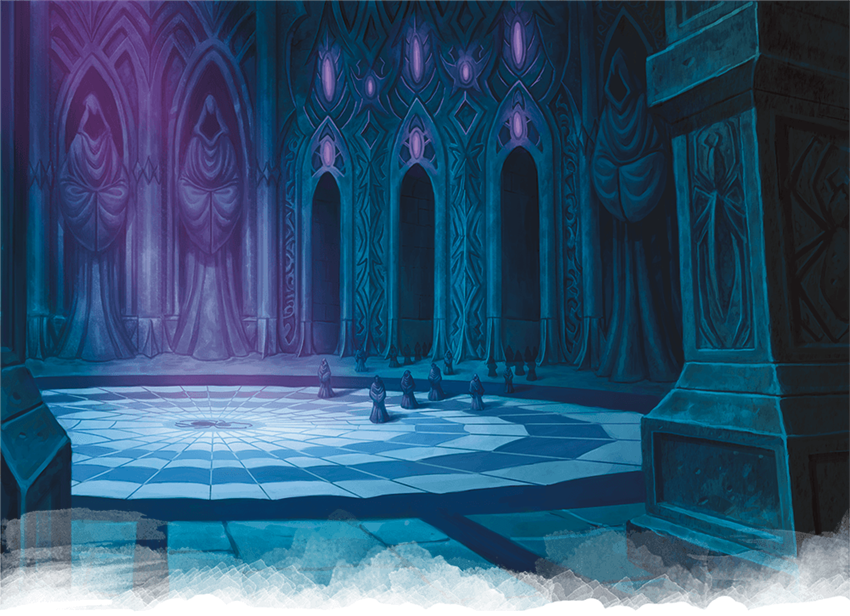
Win Conditions
Most D&D encounters are presented like a fight to the death. Monsters appear, you kill them, the encounter ends. But D&D doesn’t have to be this way; not every fight has to be to the death. In fact, in the real world, we tend to think of people who kill their enemies senselessly as war criminals and psychopathic monsters. If you create encounters where murdering everything in sight is the only way to win, then you will be turning your characters into bloodthirsty monsters. Reluctant bloodthirsty sociopaths, at best.
The fact of the matter is that most living creatures don’t want to die. Even for a cause they believe in, all but the most stalwart zealots would rather flee than die. Consider filling your encounters with more enemies than usual, but have them surrender once they’re reduced to one-quarter their maximum hit points. Some Dungeon Masters consider the “top half” of their foes hit points to be nothing but raw luck and morale, and that a creature only takes a physical wound once they’re reduced to half their hit point maximum. The term “bloodied” represents that an attack has finally drawn blood. From there on out, more and more of their hit points represent their ability to take physical blows. If you follow this assumption, then a creature reduced to one-quarter its hit point maximum has taken a grievous wound that could kill it if it chooses to fight further. That’s when most fighters raise up their hands and scream, “Mercy!”
You could go even farther with this concept of killing only when necessary. Maybe the enemy force controls a crucial location like a castle’s gatehouse or a ritual circle, or an item like a dragon’s egg or a magic artifact. By capturing that item or location, you can force the rest of the foes to retreat or surrender. Maybe the characters are attacked while traveling from point A to point B, and the only thing they have to do to win the encounter is to escape to a certain point on your map, allowing them to elude their ambushers. Or perhaps an encounter occurs while a gigantic door is being opened, an elevator is descending, or a wizard is trying to complete a minute-long ritual. Then, the only goal is to survive until the countdown clock is finished. Finally, some foes are only fighting because their commander has forced them to. If you defeat the boss, then the rest of the minions will scatter. No matter what victory conditions you include, be sure to make sure your players know about them. You could do it directly by telling them flat-out what the victory conditions are, or indirectly by having the enemies talk about what they want in a place that the characters can overhear them.
All of these alternate victory conditions help you create battles that are more tactically diverse, but they also help you and your players understand the role of violence in your story. Even though movies and video games see our heroes mowing down faceless grunts by the thousands, such wholesale slaughter is rare in the real world. Is that the kind of story you want to tell?
DMing Tip: Awarding Experience Points
If your characters insist upon killing enemies that they don't strictly have to in order to overcome a challenge, it may be because you only award XP for enemies that they kill. Try telling them that they'll gain full experience for defeating all the enemies in an encounter no matter how they clear an encounter, even if they didn't kill all of the creatures in it. This is a behavior that video games instill in a lot of players, since XP is only awarded for enemies defeated in combat. This trick can break them of that murderous habit!
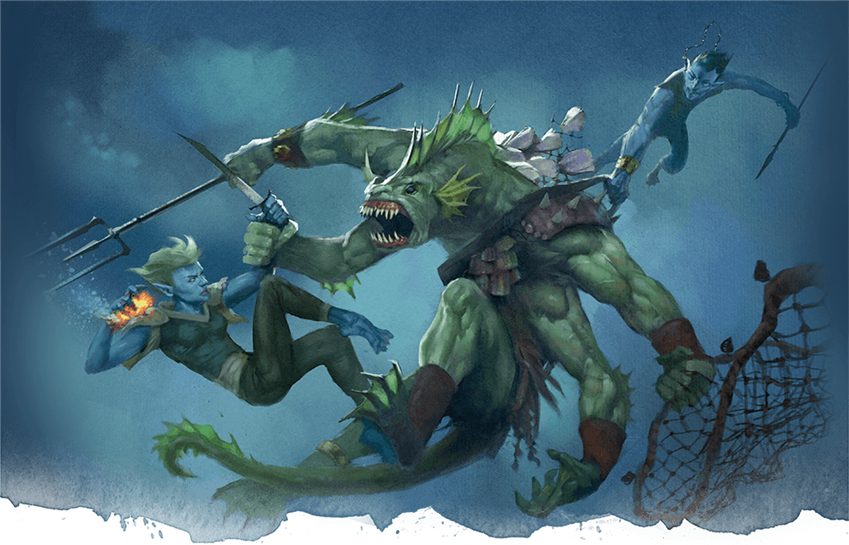
Don’t go Overboard
One of the great downfalls of tactical combat is that DMs and designers invariably get too excited for their own good. They throw in tons of terrain, position every monster perfectly, add a dozen different monster types, and top it all off with an esoteric win condition. Throwing everything but the kitchen sink into an encounter is actually bad design. Adding too many flavors that are exciting on their own into the stew creates a muddy mess that confuses the palate. The same is true for elements of a tactical encounter.
If you’re just starting out making tactical encounters, include just one interesting element. See how it works on its own. Start small, and grow bigger. Let your encounters fluctuate between “simple (with a twist)” and “a hair shy of mind-bendingly complicated.” This variety will actually make each encounter more fun for you and your players, because it gives them variety.
Advanced Tactics
There are more advanced tactics to consider when building encounters for your campaign, but they go beyond the scope of this simple primer. Let’s save topics like synergy, tactical roleplaying, and tactical ability checks for another day. Until then, try making your own tactical encounters using maps from Tactical Maps Reincarnated as inspiration!
Let D&D Beyond's digital dice handle the dice rolling while you focus on the tactics! Use D&D Beyond Encounters to plan for combat encounters and run them!
Create A Brand-New Adventurer Acquire New Powers and Adventures Browse All Your D&D Content
 James Haeck is the lead writer for D&D Beyond, the co-author of Waterdeep: Dragon Heist, Baldur's Gate: Descent into Avernus, and the Critical Role Explorer's Guide to Wildemount, a member of the Guild Adepts, and a freelance writer for Wizards of the Coast, the D&D Adventurers League, and other RPG companies. He lives in Seattle, Washington with his fiancée Hannah and their animal companions Mei and Marzipan. You can find him wasting time on Twitter at @jamesjhaeck.
James Haeck is the lead writer for D&D Beyond, the co-author of Waterdeep: Dragon Heist, Baldur's Gate: Descent into Avernus, and the Critical Role Explorer's Guide to Wildemount, a member of the Guild Adepts, and a freelance writer for Wizards of the Coast, the D&D Adventurers League, and other RPG companies. He lives in Seattle, Washington with his fiancée Hannah and their animal companions Mei and Marzipan. You can find him wasting time on Twitter at @jamesjhaeck.








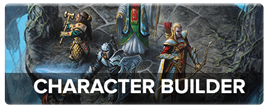
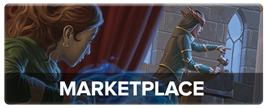
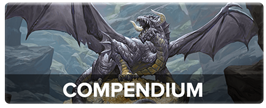
-
View User Profile
-
Send Message
Posted May 11, 2020Very useful. thanks
-
View User Profile
-
Send Message
Posted May 11, 2020"Abusive" meaning 'A major focus of the class' Might as well call Wizards using magic or barbarians using rage 'abusive'. Playing smart is not abusive. This sounds like one of those DMs whose kneejerk reaction to any kind of strategizing is to punish it and force the most straightforward mindless violence style of play. Hope that's not what you mean here.
-
View User Profile
-
Send Message
Posted May 12, 2020To be completely fair, the example given above is a ranged-focused encounter. The enemies have been modified to be more focused on ranged attacks, and positioned to give them room to use them. It’s certainly a feature rather than a bug, but Barbarians, Paladins, and melee-focused Fighters might get a little frustrated if all your encounters were in this vein.
To your point, a good designer should play into class’ gimmicks from time-to-time, as well as countering them.
-
View User Profile
-
Send Message
Posted May 12, 2020This encounter is absolutely one where ranged fighting is king! Between the ranged minions, the long sight-lines, the pit traps that make it hard to close into melee, and the boss with a special at-will ranged attack, this fight puts characters that specialize in close-quarters combat at a serious disadvantage. It's a good reminder that even the most melee-specialized characters in your party should always carry a crossbow or a few javelins, just in case.
One situation that could put ranged weapon wielders and spellcasters at a disadvantage would be a fight in a zig-zagging hallway with short sight-lines, where kobolds hide around corners, readying actions to attack anyone who pops their head around the wall. Or, a small, cramped room where wizards' area-of-effect spells are just as likely to fry their party members as their enemies. (Unless they're an evoker, of course. Sculpt Spells is a game changer.) Ranged attackers really start to suffer here when they have disadvantage shooting while within 5 feet of another foe, and when they essentially lose the ability to make opportunity attacks while wielding two-handed ranged weapons like bows and crossbows.
-
View User Profile
-
Send Message
Posted May 12, 2020Those are great ideas to give melee fighters an advantage! I'm going to make a mental note of this for use in the future. :)
-
View User Profile
-
Send Message
Posted May 12, 2020Love your work!
-
View User Profile
-
Send Message
Posted May 12, 2020I try to make it so that certain creatures have a specific hunting ground that favors their abilities:
Example I used in Strahd: a bridge over a river (200ft high) with no ledges --> perfect for harpies luring people to their death.
Party has to try and cross without falling, if players succeed the song DC the harpies will try trowing down stones on the players or push them off.
The bridge is slippery with goo so difficult terrain, and if they dash need to pass a DEX-save to not be knocked down.
Players can shoot the harpies down, but Harpies will break line-of-sight by hiding under the bridge and swooping up for the attack.
Was great fun and I now try more to match certain locations with a hunting ground
-
View User Profile
-
Send Message
Posted May 12, 2020i think you dont understand.... most monsters don't have any range attacks. spellcasting makes hard for any melee monsters to get close. so what you are telling me, by saying that... is that i should be doing the same and make all my encounters range encounters... but doing that means melee people in the group will have no fun because they will never get to combat. there are plenty of line of sight and the likes in my games... that doesn't stop any of this from hapenning. on the contrary it gives plenty more opportunities for those long range players to play their way.
this is not inherent only to TTRPGs though, trategically, range combat was always an essential part of tactics on any battlefield. because killing opponents before they reach your lines was critical in battle and the one controlling th erange better was always the winner. thats why combat in war started to be about silent movement during night raids and the likes. behind enemy lines combat and why mass combat between nations got down by a lot. by todays standard, why would you even want soldiers on the front fighting. its preferable to just shoot a nuclear missile on the enemy and be done with it. this is exactly why we are at the point we are now with drones and fighting aircrafts...
tactically, there is no reasons for melee combatants.
-
View User Profile
-
Send Message
Posted May 13, 2020I apologize for being unclear in the original post.
I did not mean that you should forget the existence of melee. I meant that you could use the terrain and general setup to shift the nature of the combat. For example, if thieves ambush the party in the crooked streets and cramped, narrow alleyways of a small town, they will fair differently than against horse archers on a open plain.
It is completely true that many monsters have no ranged options, and thus can be stuck in positions where ranged specialists can attack them, without being attacked back. However, I disagree that this means ranged attacks are unilaterally superior.
When push comes to shove, ranged attacks are entirely dependent on having a clear line-of-sight over some distance. It’s easier for melee-focused characters to deal with close spaces and get around cover. This is why, in real life, lances and swords remained staples of combat all the way to the First World War. In D&D, you often find similar situations inside caves, small castle chambers, or even some forests and towns. It all depends on how the encounter is set up, especially the terrain.
-
View User Profile
-
Send Message
Posted May 15, 2020That is what we do. I just feel advantage is a little too much of a bonus for flanking.
-
View User Profile
-
Send Message
Posted May 15, 2020This was a really great article and I hope to read more. Will topics like synergy, tactical roleplaying, and tactical ability checks be a part of an ongoing series?
This information has really boosted my encounters. Thank you!
-
View User Profile
-
Send Message
Posted May 15, 2020Agree with all of this. If your monsters are getting squished before making it within melee distance there are plenty of options you can consider.
Add HP, Up their AC, Damage resistances/ immunity, Creatures that can burrow, swim, fly or hide, Overwhelming numbers. All of those will up the challenge a bit- though I agree that using the terrain to break line of sight is king. Your PC's can't shoot at things they can't see! For example; "The Wyvern screams and flaps into the cloud of steam surrounding the bubbling hot springs. You can hear it circling the party but you can't make out its location..."
If monsters don't have a ranged attack you can always just give them one. It makes the combat far more interesting and unexpected when creatures don't stick to what the Monster manual says they can do. E.g. "The giant snake rises hissing out of the water 60 feet in front of you... and spits a stream of venom in your eyes. Roll Constitution!"
And for special occasions, give the monsters a magic item or ability that does something unusual. In your case, we're going to rip off The Phantom Menace; I'm thinking a staff carried by the Hobgoblin commander spreads a bubble of shimmering energy 40ft in radius over his squad. It blocks fast moving projectiles and spells, but allows slowly moving things like people through. Looks like the party will have to either spend their spell slots doing enough damage to the shield to destroy it, or get close and personal with the enemy.
Finally, if your players object to any of this, you can explain literally anything in D and D by saying "A wizard did it".
-
View User Profile
-
Send Message
Posted May 15, 2020Agree with all of this. If your monsters are getting squished before making it within melee distance there are plenty of options you can consider.
Add HP, Up their AC, Damage resistances/ immunity, Creatures that can burrow, swim, fly or hide, Overwhelming numbers. All of those will up the challenge a bit- though I agree that using the terrain to break line of sight is king. Your PC's can't shoot at things they can't see! For example; "The Wyvern screams and flaps into the cloud of steam surrounding the bubbling hot springs. You can hear it circling the party but you can't make out its location..."
If monsters don't have a ranged attack you can always just give them one. It makes the combat far more interesting and unexpected when creatures don't stick to what the Monster manual says they can do. E.g. "The giant snake rises hissing out of the water 60 feet in front of you... and spits a stream of venom in your eyes. Roll Constitution!"
And for special occasions, give the monsters a magic item or ability that does something unusual. In your case, we're going to rip off The Phantom Menace; I'm thinking a staff carried by the Hobgoblin commander spreads a bubble of shimmering energy 40ft in radius over his squad. It blocks fast moving projectiles and spells, but allows slowly moving things like people through. Looks like the party will have to either spend their spell slots doing enough damage to the shield to destroy it, or get close and personal with the enemy.
Finally, if your players object to any of this, you can explain literally anything in D and D by saying "A wizard did it".
-
View User Profile
-
Send Message
Posted May 16, 2020I hope you don’t mind if I steal a few of those proposals.
-
View User Profile
-
Send Message
Posted May 16, 2020Please do!
-
View User Profile
-
Send Message
Posted May 16, 2020I'm pretty sure this is my first time commenting on one of your articles. Its really nice to see a little Old School thinking applied to 5e encounters. And a little 4e terminology tossed in for good/salty measure. ;D
I think your tactical example is clear and relatable, and the guideline of 3-5 moving parts in an encounter is excellent advice for DMs.
I love using Morale and random npc/monster Reactions in my game. The DMG guidelines for Moral (pg 273) are pretty good, though I prefer the 2D6 method of B/X D&D -both do exactly the same thing though. The DMG's guide for reactions/interaction (pg244) are solid, and a quick Google will turn up older D&D methods for figuring out the starting disposition for any npcs/monsters you run into randomly, if you don't already have some idea ahead of time. I really like how these things add structure to parts of the game that are often just left to DM fiat, and thus can be very inconsistant from session to session.
Breaking players of the "must kill everything!" mentality is a real challenge if they grew up playing video game RPGs, and 5e doesn't really do much to discourage that kind of play. I ran my players through a VERY good "teaching dungeon" written for old-school D&D called Tomb of The Serpent Kings ( https://www.drivethrurpg.com/product/252934/Tomb-of-the-Serpent-Kings--Deluxe-Print-Edition ) The PDF is free.
Anyhoo, most of the dungeon is about overcoming things that low level PCs can't slug it out with. Luring Black Puddings into traps initially intended to kill the PCs, shoving indestructible skeleton-jellies around with spears and shields, outhitting a basilisk "guard dog", and bartering with a necromancer? It's a helluva good lvl 1-3 adventure! The change in thinking of my players since we ran ToTSK has been impressive. They keep me on my toes all the time now and its a lot more for DMing them.
Point is this: give your players complicated but straight-forward puzzles and they will usually rise to the challenge. And your job of DM will become even more fun.
-
View User Profile
-
Send Message
Posted May 31, 2020Awesome!! Just a question: Why is it called New Player's Guide? It seems like it's for DMs.
-
View User Profile
-
Send Message
Posted May 31, 2020Because DMs are players, too.
-
View User Profile
-
Send Message
Posted Jan 15, 2021there are plenty of ways to counter magic users and range fighters. create cover, use traps ( a caster might change the angle of a spell if they can possibly push a monster into a pit with a well placed spell), use spell casters against them, use elevation to block sight or increase sight or terrain hazards where a stalagmite might fall on them. a caster might need to move to gain cover. A simple goblin with a wand of magic missiles can really mess with a caster or a druid with thorn growth. casters are squishy they should use cover or an archer will take them out.
yes they don't move around as much but that doesn't mean they don't or shouldn't think of tactics they might want to buff an ally, debuff the enemy, cause a distraction, do they want to do an aoe or a single target? simply moving your enemies around can change their spell choice. spread out enemies a buff spell might be better because you can buff multiple allies while a single spell would hit just one enemy. or the enemy might line up for catapult or lighting spell that fire ball wouldn't work on. one big Boss monster? easy don't waste your time on aoe spells instead focus fire, buff and debuff. use small spaces sometimes that might be really bad for casters who only have range or use hidden monsters that the party didn't see and surround the party or maybe they recognize the spell caster and target them with a hold person or rally an attack against them
-
View User Profile
-
Send Message
Posted Jan 15, 2021true many players just want to look cool, but you can do a little of both by using the terrain and traps. imagine poisonous gas bubbles from the bog in a certain location or hot steam from the cracks in the ground. if you are doing theater of the mind you don't have to give exact details of where these are just let the players know if they are close to them or if the enemy is close to them. the distances are less important in theater of the mind. when using a map is much easier to use some of these tactics because they are visually on the map. Start off small and build up as it was said in the article too much in a battle is just as bad as too little